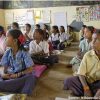No products in the cart.
Enhancing high school learning for Indian students
 -Kadambari Rana, Educationist, Coach and Parenting Mentor
-Kadambari Rana, Educationist, Coach and Parenting Mentor
Learning is a continuous and organic process. In terms of school education, learning at any stage is interwoven and forages progressively into subsequent stages. In other words, learning in primary school, middle school and high school are interconnected. Therefore, to have a comprehensive understanding of high school learning experiences and outcomes, an in-depth study of records of skills gained or missed during primary and middle school stages, becomes imperative.
Since there are backward and forward integrations and implications of educational practices therefore a correlation between learning experiences at primary and middle school stages and learning outcomes during high school stage cannot be contested.
As per the recommendations of NEP 2020 India’s school system will now be a total of 15 year of formal education, since three additional years have been added to the primary stage. This demonstrates that the government officially recognizes the long-term importance of enhancing early years learning and the impact it has on the latter years of student life.
India is characterized by a system of education which is humungous not only in terms of absolute number of schools and population size of school going children but also in terms of diversity in curriculum.
The curriculum options range from the CBSE, ICSE, state boards to international boards options like IB and IGCSE. Although variety in terms of the methods of delivery of education is important, given the socio-economic-cultural diversity in our country, yet homogeneousness in skills sets acquired at every progressive stage is essential to ensure acquisition of ‘minimum’ skills set.
The single largest reason for the growing popularity for international curricula is the failure of our indigenous curricula to reinvent themselves to meet the needs of a 21st century learner. Students are largely going through a system of repetitive and outdated curriculum with subject streams limited to the broad category of humanities, commerce and science. Subject choice is only an illusion! In an era of multidisciplinary approach, a typical high school student in India is still studying exactly the same content delivered three to four decades ago.
Irrespective of the curriculum, an average high school student is battling with performance pressure, anxiety, self-doubt, depression and stress. Students are doing arts, theatre, sports, debates, inter-school’s competitions, not for the LOVE of learning but to build a profile.
That is not all, there is a unique feature of social pressure to date and be popular on social media. So, today’s high school student is certainly juggling with a lot more pressure than a typical high school student a decade ago.
In general, being a high school student in India means living a high-pressure academic, extracurricular and social life! High school students are running from school to home and home to tuition centres to conquer the impossible cut-offs set by our colleges and universities.
Everyone wants to be better and best and is therefore racing against time to have additional feathers on their cap. In the absence of any true spirit of teaching or learning, the madness never ends!
Whatever may be the context of times, high school education it is to bring forth the innate capacity and capability of each child and to go beyond the realms of technical knowledge and basic skills?
High school education should not be limited to a few deliberate concepts and pre-planned strategies. In the words of western philosopher Lodge, “All experiences are said to be educative- the bite of mosquito, the taste of a watermelon, the experiences of falling in love, of flying in an aeroplane, of being caught in a storm in a small boat experiences have directly educative effect on us. Whatever broadens our horizon, deepens our insight, refines our reactions, and stimulate thought and feeling educates us.”
Also read: 42% Indian students embrace blended learning reveals: Edvoy survey
Purpose of high school education
- To ensure that students have attained holistic development in the areas of; material world, mental application, moral robustness, physical health and spiritual understanding of the perishable and the permanent aspects of life
- To build in students 21st century skills under the broad categories of Learning Skills, Literacy Skills and Life Skills. Learning skills include critical thinking, creative thinking, collaborating, communicating. Literacy Skills would include aspects such as information literacy, media literacy and technology literacy. Life skills such as social skills, emotional skills, leadership skills, training in household chores, productivity, initiative, flexibility and resilience.
- Students passing out of school should be fearless and confident
- Schools should consider each student a precious resource, not only in their own lives but also individuals who are ready to contribute positively towards the social, cultural and economic spheres of their country
- Any educational institute should be able to bring forth the innate capacity and capability of each child
- Schools should be able to provide experiences to the child that are beyond the realms of technical knowledge and basic skills
- Cultivate the mind of the student in such a way that she can accomplish all her aims in life
- Create a curriculum that utilizes the full potential of the body, mind and spirit
- Enhance the child’s personality
- Work in close co-ordination with the parents of the child to optimize the child’s potential
- Teachers of the school must have a comprehensive understanding of the various components of the child’s environment and that of its developmental domains to effectively assist the child in attaining her milestones
- Provide abundance of love and reassurance
- Have physical education as an integral part of the curriculum
- Create opportunities for the child to understand the community all around her
- Exposure should be given to life in the rural areas of the country so that children remain rooted and are motivated to work towards uplifting the country
- Exposure to diverse languages, cultural histories, theatre, dance, art and music should be given to students to develop creative and aesthetic abilities
The author is an educationist who is currently working on documenting her observations on children’s play and learning experiences.






 -Kadambari Rana, Educationist, Coach and Parenting Mentor
-Kadambari Rana, Educationist, Coach and Parenting Mentor








Add comment